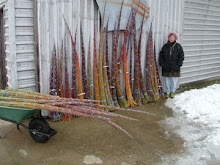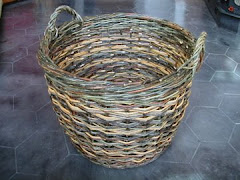So I decided to try constructing bait feeding stations and have been pleased with the results. Here is one of them.
They are made of 1 1/4" ABS pipe cut in 8" lengths and you need 3 pieces for each station. You will also need a T fitting of the same size and a 1 1/4" plumbing test cap or perhaps a large cork would be cheaper if you can find it. I have trouble getting the caps off to refill the centre pipe with bait. The main thing is to keep the bait dry so the cap needs to do the job well. We used ABS cement to fasten into the T fitting. To set up, just tie it to a stake, making sure the base is in contact with the ground and level so rain won't collect inside.
As for spacing of the stations, I set up one every 15 feet or so because there was so much evidence of rodent activity. They should probably be put out in autumn to discourage the usual search for good nesting sites for the winter, so you have a few months to get the stations made up and ready for use. There are several good commercial baits available, I used a single feeding anti-coagulant rodenticide called Wilsarin, put out by Wilson. Their active ingredient is called bromadiolone and it seems to be working just fine although the grain type might resist moisture better.
I took off the geotextile and will mulch with straw as usual over the summer and consider removing it after the leaves have dropped. I was replacing the mulch each spring anyway to resolve a fungus problem.












7 comments:
Thanks Frances, for the information about the feeding stations. We had lots of rodents this winter - both in the willow field and in parts of the garden - and they did a lot of damage. I'll certainly put up something in the fall at different places.
My home town of Hutchinson, KS where my parents still live, has a huge infestation of prairie dogs. Seriously, around the mall and Home depot you will see several hundred at one time. Cute little critters, but they need something such as this. The town cannot agree on what to do with them. On another note, I have something fun for you to pick up on my blog post today.
Blessings,
Nancy
Hi there!!! Do you have any pitures of bird nest
Hi Frances, you've been tagged! I have nominated you for a MeMe Award. If you are up to it, see details and rules on my blog.
Lene
Fantastic and useful we blog thanks for publishing this.it's useful and informative.keep up the great.
Rodent Control
Further refinement for covering the vertical pipe. I found that cylindrical plastic shampoo or lotion containers work well. Cut the top off where it tapers and set upside down on the pipe. Easy to get off and it stays on just fine.
The problem with using rodenticides in the open is non-target species then eat the poisoned corpses and then get poisoned and die themselves. Not a good thing to have on your conscience. It is most important to pick up any dead rodents and put them in the bin in a plastic bag.
Barn owls in the UK have suffered considerably because of this. Use traps instead of bait stations. These are good multi-catch traps.
https://www.amazon.com/gp/product/B001VGW06E/ref=ppx_yo_dt_b_asin_image_o03_s00?ie=UTF8&psc=1
Post a Comment